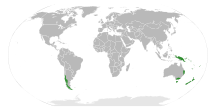Southern beech
| Southern beeches Temporal range: 72–0 Ma Late Campanian–Present |
|
|---|---|
 |
|
| The roble beech (Nothofagus obliqua) from South America | |
| Scientific classification | |
| Kingdom: | Plantae |
| (unranked): | Angiosperms |
| (unranked): | Eudicots |
| (unranked): | Rosids |
| Order: | Fagales |
| Family: |
Nothofagaceae Kuprian. |
| Genus: |
Nothofagus Blume |
 |
|
| The range of Nothofagus. | |
| Synonyms | |
|
|
Nothofagus, also known as the southern beeches, is a genus of 43 species of trees and shrubs native to the Southern Hemisphere in southern South America (Chile, Argentina) and Australasia (east and southeast Australia, New Zealand, New Guinea and New Caledonia). The species are ecological dominants in many temperate forests in these regions. Some species are reportedly naturalised in Germany and Great Britain. The genus has a rich fossil record of leaves, cupules and pollen, with fossils extending into the late Cretaceous and occurring in Australia, New Zealand, Antarctica and South America. In the past, they were included in the family Fagaceae, but genetic tests revealed them to be genetically distinct, and they are now included in their own family, the Nothofagaceae (literally meaning "false beeches" or "bastard beeches").
The leaves are toothed or entire, evergreen or deciduous. The fruit is a small, flattened or triangular nut, borne in cupules containing one to seven nuts.
Nothofagus species are used as food plants by the larvae of hepialid moths of the genus Aenetus, including A. eximia and A. virescens.
Many individual trees are extremely old, and at one time, some populations were thought to be unable to reproduce in present-day conditions where they were growing, except by suckering (clonal reproduction), being remnant forest from a cooler time. Sexual reproduction has since been shown to be possible. Although the genus now mostly occurs in cool, isolated, high-altitude environments at temperate and tropical latitudes the fossil record shows that it survived in climates that appear to be much warmer than those that Nothofagus now occupies.
...
Wikipedia
